
This short video covers many anatomical terms.
- Subject:
- Anatomy/Physiology
- Life Science
- Material Type:
- Activity/Lab
- Author:
- Bruce Forciea
- Date Added:
- 03/28/2018

This short video covers many anatomical terms.

This article describes the following five basic terms that are essential to understand the coordination chemistry.1. Central ion/atom 2. Ligand3. Coordination Number 4. Coordination sphere and complex ion 5.Oxidation number of the central metal atom

This lesson explains directional terminology used to describe the positions of structures relative to other structures or locations in the body. Learners will apply directional terminology by dissecting a three-dimensional object. Lesson developed from original resource by Bobbi D. Dittmer.
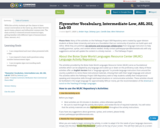
With this activity students get the chance to have casual conversation in the warm up, about their favorite sports teams, players and influential commercials. The main activity is centered around numerical signs, getting familiar with different types of measurement (time, amount, etc.)
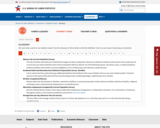
Not sure what a word on our website means? Use the Glossary of Terms below to find the definition! You’re on your way to becoming an economist.
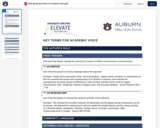
The handout breaks down some implicit expectations related to academic voice, such as when and how to use first-person writing, jargon, style, and sentence variation.


Expressions
Type of Unit: Concept
Prior Knowledge
Students should be able to:
Write and evaluate simple expressions that record calculations with numbers.
Use parentheses, brackets, or braces in numerical expressions and evaluate expressions with these symbols.
Interpret numerical expressions without evaluating them.
Lesson Flow
Students learn to write and evaluate numerical expressions involving the four basic arithmetic operations and whole-number exponents. In specific contexts, they create and interpret numerical expressions and evaluate them. Then students move on to algebraic expressions, in which letters stand for numbers. In specific contexts, students simplify algebraic expressions and evaluate them for given values of the variables. Students learn about and use the vocabulary of algebraic expressions. Then they identify equivalent expressions and apply properties of operations, such as the distributive property, to generate equivalent expressions. Finally, students use geometric models to explore greatest common factors and least common multiples.

Students play an Expressions Game in which they describe expressions to their partners using the vocabulary of expressions: term, coefficient, exponent, constant, and variable. Their partners try to write the correct expressions based on the descriptions.Key ConceptsMathematical expressions have parts, and these parts have names. These names allow us to communicate with others in a precise way.A variable is a symbol (usually a letter) in an expression that can be replaced by a number.A term is a number, a variable, or a product of numbers and variables. Terms are separated by the operator symbols + (plus) and – (minus).A coefficient is a symbol (usually a number) that multiplies the variable in an algebraic expression.An exponent tells how many copies of a number or variable are multiplied together.A constant is a number. In an expression, it can be a constant term or a constant coefficient. In the expression 2x + 3, 2 is a constant coefficient and 3 is a constant term.Goals and Learning ObjectivesIdentify parts of an expression using appropriate mathematical vocabulary.Write expressions that fit specific descriptions (for example, the expression is the sum of two terms each with a different variable).
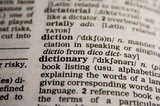
This Personal Finance dictionary contains terms and definitions from each of NGPF's units in the Curriculum. https://www.ngpf.org/curriculum
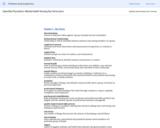
The Key Terms resource is provided in .docx format. It includes terms extracted directly from the textbook and organized by chapter. Each key term is bolded and followed by its definition in context.

This lesson will be a real-world scenario-based reading module for Reading Scientific and Technical Text, for readers at level 7. Through an interactive visual scenario, learners will be introduced to a sample loan application form, and will be walked through the meaning and purpose of primary portions of the form and challenging terminology in it.